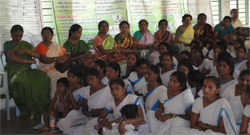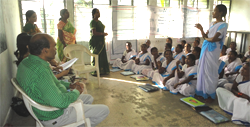Pregnant women who had full antenatal care is only 42.5% in the state of AP followed by 88.5 % with institutional deliveries. Percentage of children weighed at Birth is 91.4 % and prevalence of low birth weight is 5.7% Children under 3 years breastfed within one hour of birth is 54.9. The prevalence of underweight in under 5 children is 10.1%. Received full vaccination is 60.9% and measles vaccine is 86.6% (DLHS-4 survey). The state of Andhra Pradesh has an infant mortality rate as 39 per 1000live births and neonatal mortality rate as 33 per 1000 live births ( SRS 2013) and under 5 mortality rate as 52 per 1000 live births).
By 2030, end preventable deaths of new borns and children under 5 years of age, aiming to reduce neonatal mortality to at least as low as 12 per 1,000 live births and under-5 mortality to at least as low as 25 per 1,000 live births (Sustainable Development Goal). Promote 100% full antenatal care, institutional deliveries and full immunisation for children under -5.

The ASHA is a woman resident in the community selected by her community, who is trained and supported to function in her own village / slum with a goal to provide primary medical care, advice on sanitation, hygiene, ante-natal and post-natal care, escorting expectant mothers to hospital for safe delivery.

Status of the programme
The selection of ASHA has been in near completion in rural areas of the state according to the norms laid by NRHM. The general norm will continue to be "One ASHA" per 1000 population. Where as in Urban habitations with a population of 50,000 and above one ASHA is selected for every 2000-2500 population. At present there are 37727 rural ASHAs and 2502 urban ASHAs in position.
Training
Capacity building of ASHA is a continuous process. Building ASHAs knowledge base and skills is critical in enhancing her effectiveness to achieve the desired health care outcomes. ASHAs in the state have now completed two rounds of HBNC training. The 3rd round of training is under process. Out of 37727 rural ASHAs, 34603 rural ASHAs received 1st round and 29710 up to 2nd round of training. With regard to urban ASHAs, 1387 completed 1st round and 1081 completed 2nd round. The third round is under process. Total Supervising staff trained as ASHA facilitators is 1634 and are trained in facilitator module and HBNC. They in turn give HBNC orientation to ASHAs on ASHA Day meeting.
ASHA Drug Kit & HBNC Kit : ASHA Drug Kit & HBNC kits already distributed to all ASHAs and the required drugs are being filled from time to time during regular PHC meeting.
ASHA Grievance Redressal Committee: The Grievance Redressal Committee has already established in Srikakulam, Vizianagaram, Visakhapatnam, East Godavari, West Godavari, Krishna, Kadapa, Ananthapur & Kurnool districts and the remaining are under process.
VHSNC Status: Village health sanitation Nutrition Committee is expected to take collective action on issues related to health. They were particularly envisaged as being central to "local level community action" under NRHM. It provides an institutional mechanism for the community to be informed of health programmes and government initiatives. Further they also provide a platform for convergent action on social determinants and all public services directly or indirectly related to health. Annual untied fund of Rs.10000/- provided to GKS to take up local level action to address health related issues. ASHA is the member secretary and convenor of VHSNC . As on date, 12,958 VHSNCs are formed and training will be conducted through SERP (CRPs)
Mahila Aarogya Samitis : MAS is one of the key interventions under NUHM aimed at promoting community participation in health at all levels, including planning, implementing, and monitoring of health programs. MAS is expected to take collective action on issues related to health, nutrition, sanitation, water and social determinants at Slum level. Each MAS covers approximately up to 50-100 HHs at slum level. In the state of AP, MEPMA is involved in the constitution and training of MAS. As on date, 9015 MAS have been formed as against the target of 9988. At the district level, 8250 MAS have been trained.
Support Structure for Monitoring ASHAs, VHSNCS and MAS : State Level ASHA Mentoring Group has been established. It is proposed to establish district and block level mentoring groups at the earliest for developing supportive monitoring structure.
Process Indicators:
(a) Number of ASHAs selected by due process
(b) Number of ASHAs trained
(c) % of ASHAs attending review meetings after one year
Outcome Indicators:
(a) % of new born who were weighed and families counselled
(b) % of babies breast fed in first hour of birth
(c) % of low birth weight babies
(d) % of children who have received full immunisation
(e) % of children who have received measles vaccination
(f) % of immunisation session where ASHA was present
(g) % of women who received 3 antenatal check-ups
(h)% of institutional deliveries
(i) % of JSY payments for institutional deliveries
(j) % of ASHAs who have got incentives under JSY
(k) VHSNC fund utilisation
(l) Number of children admitted for respiratory infections
(m) Number of children treated for Diarrohea
(n) Reported still birth
(o) Reported still birth rate
(p) Reported perinatal mortality
(q) Reported neonatal mortality
(g) % of unmet need for spacing contraception among BPL
(h) % of fever cases who received chloroquine within first week in a HMIS endemic area
Impact indicators
(a) IMR
(b) Child malnutrition rates
(c) Number of cases of TB/leprosy cases detected as compared to previous year.